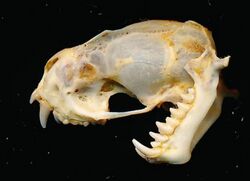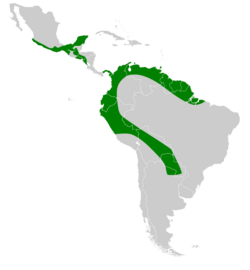Biology:Big crested mastiff bat
| Big crested mastiff bat | |
|---|---|

| |
| Scientific classification | |
| Domain: | Eukaryota |
| Kingdom: | Animalia |
| Phylum: | Chordata |
| Class: | Mammalia |
| Order: | Chiroptera |
| Family: | Molossidae |
| Genus: | Promops |
| Species: | P. centralis
|
| Binomial name | |
| Promops centralis Thomas, 1915
| |

| |
The big crested mastiff bat (Promops centralis), is a bat species from South and Central America.
Taxonomy
It was described as a new species in 1915 by British zoologist Oldfield Thomas. The holotype was collected by George F. Gaumer, and presented to Thomas by Osbert Salvin.[2]
Description
It can be differentiated from the other species of Promops, the brown mastiff bat, by its longer forearm. The brown mastiff bat has a forearm length less than 50 mm (2.0 in), while the big crested mastiff bat has one greater than 51.5 mm (2.03 in). It has a dental formula of 1.1.2.32.1.2.3 for a total of 30 teeth.[3]
Biology and ecology
It is a social animal, roosting in small colonies of up to 6 individuals during the day. These roosts consist of the space underneath tree bark, the undersides of palm leaves, or tree hollows.[3] Its search calls have an average duration of 20.6 ms, with a starting frequency of 23.0 kHz, an ending frequency of 25.6 kHz, and a peak frequency of 24.7 kHz.[4]
Range and habitat
The big crested mastiff bat is found in Central and South America. It is found in Argentina , Belize, Bolivia, Brazil , Colombia, Ecuador, El Salvador, French Guiana, Guatemala, Guyana, Honduras, Mexico, Nicaragua, Paraguay, Peru, Suriname, Trinidad and Tobago, and Venezuela. It is found at a range of elevations, from sea level to 1,800 m (5,900 ft).[1]
References
- ↑ 1.0 1.1 Solari, S. (2019). "Promops centralis". IUCN Red List of Threatened Species 2019: e.T88087651A22036112. doi:10.2305/IUCN.UK.2019-1.RLTS.T88087651A22036112.en. https://www.iucnredlist.org/species/88087651/22036112. Retrieved 19 November 2021.
- ↑ Thomas, Oldfield (1915). "The Annals and magazine of natural history; zoology, botany, and geology". Annals and Magazine of Natural History 16 (91): 61–64. doi:10.1080/00222931508693686. https://biodiversitylibrary.org/page/22131159.
- ↑ 3.0 3.1 Gardner, A. L. (2008). Mammals of South America, Volume 1: Marsupials, Xenarthrans, Shrews, and Bats. 1. University of Chicago Press. p. 434–435. ISBN 978-0226282428.
- ↑ González-Terrazas, Tania P.; Víquez, Luis R.; Ibarra-Macías, Ana; Ruíz, Adrián Tonatiuh; Torres-Knoop, Leonora; Jung, Kirsten; Tschapka, Marco; Medellín, Rodrigo A. (2016). "New records and range extension of Promops centralis (Chiroptera: Molossidae)". Revista Mexicana de Biodiversidad 87 (4): 1407–1411. doi:10.1016/j.rmb.2016.10.008.
Wikidata ☰ Q1829340 entry
 |


